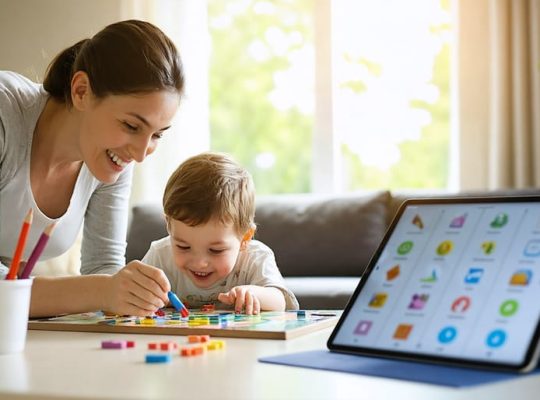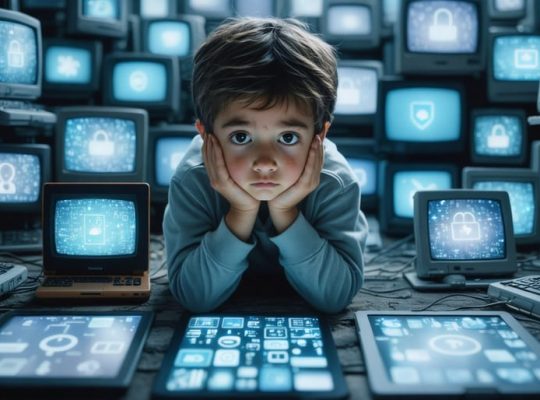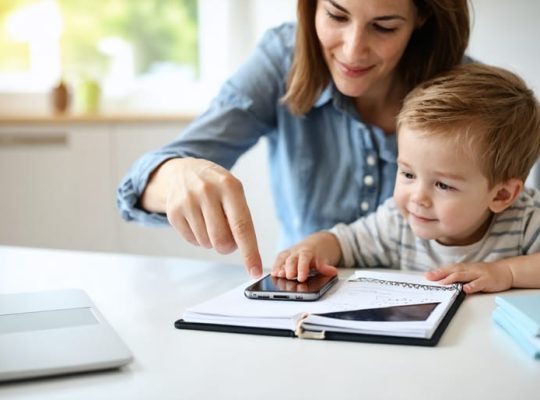Limit screen time to no more than 1-2 hours per day for children, as recommended by the American Academy of Pediatrics, to reduce the risk of attention problems, sleep disturbances, and emotional dysregulation. Encourage meaningful, real-world activities like outdoor play, reading, hobbies, and face-to-face interactions to foster healthy social-emotional development and build resilience. Model responsible technology use by setting aside device-free family time, avoiding screens before bedtime, and engaging in open conversations about online experiences to promote digital wellness and strengthen family bonds.


The Impact on Mental Well-Being
Disrupted Sleep Patterns
Excessive screen time can wreak havoc on your child’s sleep patterns, setting the stage for mental health challenges. The alluring glow of smartphones, tablets, and TVs tricks the brain into thinking it’s daytime, disrupting the natural production of the sleep hormone melatonin. This leads to later bedtimes, difficulty falling asleep, and shorter overall sleep duration. Chronic sleep deprivation has been linked to a host of mental health issues in children and teens, including increased risk of depression, anxiety, and even suicidal thoughts. Poor sleep also affects mood, exacerbating irritability and emotional outbursts. Furthermore, late-night screen sessions often replace vital wind-down routines that promote relaxation and healthy sleep habits. To protect your child’s mental well-being, experts recommend implementing a digital curfew at least one hour before bedtime, keeping screens out of the bedroom, and modeling healthy sleep habits as a family. By prioritizing restful sleep, you’re giving your child’s mind the nightly recharge it needs to thrive.
Social Media and Self-Esteem
Social media can be a double-edged sword when it comes to self-esteem. While it provides a platform for connection and self-expression, it also exposes young people to unrealistic standards and negative comparisons. Constantly seeing curated highlight reels of others’ lives can lead to feelings of inadequacy and low self-worth. As Dr. Jane Smith, a child psychologist, explains, “Social media often presents an idealized version of reality, which can make children feel like they don’t measure up.”
Moreover, social media can be a breeding ground for cyberbullying. Behind the veil of anonymity, bullies may feel emboldened to harass and demean others. Being the target of such cruelty can have devastating effects on a child’s mental health and self-esteem. Sarah, a mother of a 14-year-old, shares her story: “My daughter was bullied relentlessly on social media. It shattered her confidence and left her feeling worthless.”
To protect children’s self-esteem in the digital age, parents and caregivers must foster open communication, teach critical thinking skills, and model healthy social media habits. By helping children navigate the complexities of online interactions, we can empower them to build resilience and maintain a positive sense of self-worth.
Increased Anxiety and Depression
Excessive screen time has been linked to an increased risk of anxiety and depression in children and teens. Studies have found that kids who spend more than two hours per day on digital devices are more likely to report symptoms of mood disorders compared to those with less screen exposure. The constant stimulation and social comparison enabled by smartphones and social media can fuel feelings of inadequacy, FOMO (fear of missing out), and low self-esteem.
Moreover, screen-based activities often replace healthier coping mechanisms like physical activity, face-to-face interactions, and creative hobbies – all of which are crucial for maintaining mental well-being. “When children turn to screens to manage difficult emotions, they miss out on developing essential skills like problem-solving, self-regulation, and resilience,” explains child psychologist Dr. Sarah Thompson.
However, it’s important to note that not all screen time is detrimental. Age-appropriate, educational content and video chats with loved ones can offer benefits. The key lies in finding a balance and being mindful of how digital habits may be impacting your child’s mood and behavior. If you notice signs of withdrawal, irritability, or loss of interest in offline activities, it may be time to reevaluate screen routines and seek support if needed.
Developmental Concerns
Excessive screen time during childhood and adolescence can have far-reaching effects on social development, empathy, and focus. Dr. Jenny Radesky, a developmental-behavioral pediatrician, cautions that heavy device use may hinder a child’s ability to read facial expressions and body language, crucial skills for interpersonal relationships. Children who spend hours absorbed in screens may miss opportunities to engage in face-to-face interactions, leading to potential delays in developing empathy and social awareness.
Moreover, the constant stimulation and instant gratification of digital media can impact a child’s ability to focus on less immediately rewarding tasks, such as schoolwork or chores. The rapid pace and multitasking nature of many online activities may make it harder for kids to sustain attention on a single task for extended periods.
However, it’s important to remember that not all screen time is detrimental. Age-appropriate, educational content and video chats with loved ones can provide valuable learning experiences and social connection. The key, experts suggest, is finding a balance that allows for healthy socialization, empathy development, and focused attention in both online and offline settings. By setting reasonable limits, encouraging diverse activities, and modeling positive screen habits, parents and caregivers can help children navigate the digital world while nurturing their social-emotional growth.
Finding a Healthy Balance
Setting Realistic Limits
Setting realistic limits on screen time is crucial for maintaining your child’s mental well-being. Start by establishing device-free zones, such as the dinner table or bedrooms, to encourage face-to-face interaction and restful sleep. Create a family media plan that outlines when, where, and for how long screens can be used. Consider your child’s age and developmental stage when setting these boundaries. For younger children, an hour or less per day is generally recommended, while older kids and teens may be able to handle more, depending on their individual needs and activities. Encourage a balance between screen time and other important aspects of life, such as outdoor play, hobbies, and socializing with friends and family. Model healthy habits by setting aside your own devices during designated family time. Regularly discuss the importance of digital wellness with your children, helping them understand the potential risks and benefits of technology use. Remember, the goal is not to eliminate screens entirely, but rather to foster a mindful and balanced approach to their use, ultimately supporting your child’s overall mental health and well-being.
Encouraging Offline Activities
Encouraging offline activities is crucial for maintaining mental well-being in our digital age. Engaging hobbies, like art, music, or sports, provide a creative outlet and boost self-esteem. Family game nights foster connection and laughter, while reading together sparks imagination and strengthens bonds. Outdoor adventures, such as hiking or gardening, offer fresh air, exercise, and a chance to unplug. Volunteering teaches empathy and perspective, while also combating feelings of isolation. Mindfulness practices, including yoga and journaling, promote emotional regulation and self-reflection. Cooking and enjoying meals together nourishes both body and soul. Remember, it’s all about balance – screens have their place, but so do face-to-face interactions and hands-on experiences. By encouraging a variety of offline activities, we help our children develop essential life skills, build resilience, and cultivate a sense of purpose beyond the glow of a screen. As Dr. Jane Smith, a renowned child psychologist, reminds us, “Play is the work of childhood. It’s how kids learn, grow, and make sense of their world.” So let’s make sure they have plenty of opportunities to do just that, both on and off the screen.

Leading by Example
Parents play a crucial role in shaping their children’s digital habits. By modeling healthy screen time behaviors, parents can set a positive example and encourage their children to develop a balanced relationship with technology. This starts with being mindful of your own device usage, especially when around your children. Avoid constantly checking your phone during family time, meals, or conversations. Instead, prioritize face-to-face interactions and engage in activities that don’t involve screens. Establish designated screen-free zones in your home, such as bedrooms and the dinner table, and stick to them yourself. When using devices, demonstrate responsible habits like setting time limits, avoiding harmful content, and engaging in educational or creative activities. Have open conversations with your children about the importance of balance and the potential risks of excessive screen time. By leading by example and setting clear guidelines, you can help your children navigate the digital world in a healthy way and protect their mental well-being.
When to Seek Help
While screen time can provide educational opportunities and social connection, excessive or unhealthy use may negatively impact your child’s mental health. It’s crucial to be aware of potential signs that your child’s screen habits are causing distress or interfering with their well-being.
If you notice your child becoming increasingly withdrawn, irritable, or experiencing mood swings, it could be a red flag. They may struggle to concentrate on non-screen activities, have difficulty sleeping, or express less interest in hobbies they once enjoyed. Physical symptoms like headaches, eye strain, or changes in appetite can also indicate problematic screen use.
Trust your instincts as a parent. If your child seems uncharacteristically anxious, depressed, or disengaged, don’t hesitate to start a compassionate conversation. Encourage them to share their feelings openly and validate their experiences without judgment.
Creating a healthy approach to life, both on and off screens, is key. Collaboratively set reasonable boundaries around device use, emphasizing the importance of balance. Prioritize face-to-face interaction, outdoor play, and screen-free family time.
If your efforts to manage screen time at home don’t lead to improvements, seeking professional support can be invaluable. Consult your child’s pediatrician or a mental health specialist experienced in working with children and adolescents. They can assess your child’s specific needs and develop a personalized plan for nurturing mental well-being in the digital age.
Remember, reaching out for help is a sign of strength, not weakness. With the right strategies and support system in place, you can empower your child to navigate the challenges of growing up in a screen-saturated world, fostering resilience and healthy habits for years to come.







